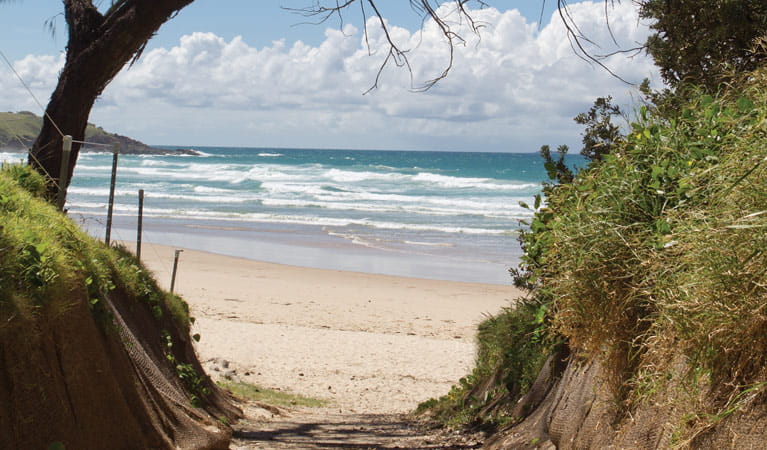Mullaway Beach and Headland
Coffs Coast Regional Park
Overview
Head south from Arrawarra to discover beautiful Mullaway Headland and Beach, near Coffs Harbour. Make the most of its picnic area and barbecues, go fishing or swimming.
- Where
- Coffs Coast Regional Park in North Coast
- Accessibility
- Medium
Mullaway Beach and Headland sit in a sleepy hamlet that’s highly regarded among fishermen.
Whether you spend your time at Mullaway fishing, swimming or bodyboarding, you’re bound to feel instantly welcome at this lovely beach. As well as great fishing and waves, there’s a small picnic area and children’s playground.
If you’re clever enough to catch a fish or two, you can cook them up on the barbecues and then relax among the paperbark trees while the kids play on the swings.
Be sure to take the headland walk for sensational views – steep cliffs, rock ledges and Solitary Islands Marine Park are all stand-outs.
Map
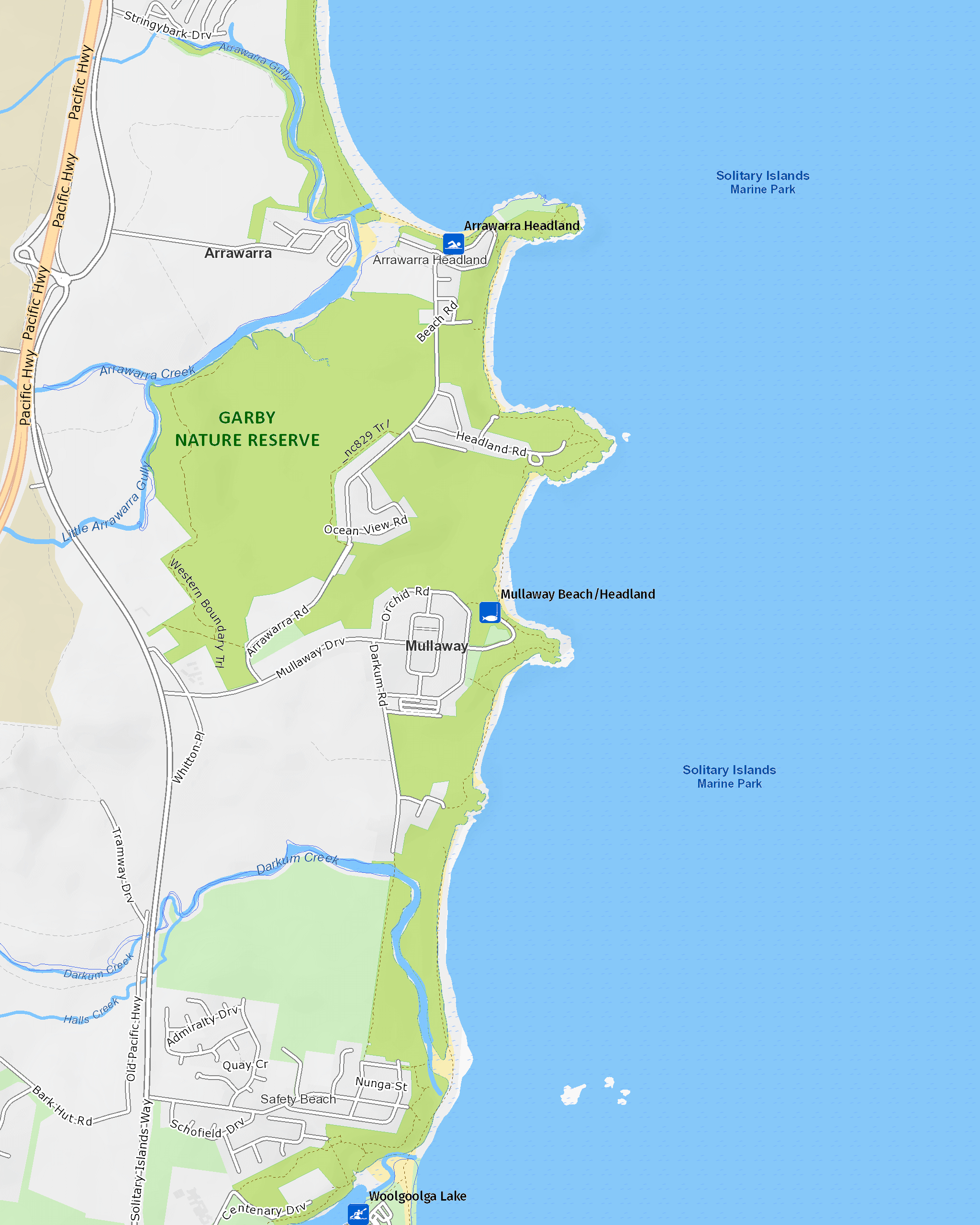
Map legend

Local alerts
For the latest updates on fires, closures and other alerts in this area, see https://www.nationalparks.nsw.gov.au/things-to-do/fishing-spots/mullaway-beach-and-headland/local-alerts
General enquiries
- National Parks Contact Centre
- 7am to 7pm daily
- 1300 072 757 (13000 PARKS) for the cost of a local call within Australia excluding mobiles
- parks.info@environment.nsw.gov.au
Park info
- in Coffs Coast Regional Park in the North Coast region
Coffs Coast Regional Park is always open but may have to close at times due to poor weather or fire danger.
Visitor info
All the practical information you need to know about Mullaway Beach and Headland.
Getting there and parking
Mullaway Headland and Beach are in the northern part of Coffs Coast Regional Park, south of Arrawarra Headland. To get there, turn east onto Mullaway Drive and continue for approximately 1.5km to the headland and picnic reserve. You can access the beach via a paved path onto the headland.
Road quality
- Sealed roads
Vehicle access
- 2WD vehicles
Weather restrictions
- All weather
Parking
Parking is available at Mullaway Beach and Headland in a concrete carpark, including 2 accessible parking spaces. It can be a busy place on the weekend, so parking might be limited.
Best times to visit
Spring
Head to one of the Park's headlands for stunning coastal views and to watch whales.
Summer
The beaches of the park are your playground - go swimming surfing, snorkling and more.
Winter
A great time to walk the Solitary Islands coastal walk.
Weather, temperature and rainfall
Summer temperature
Average
17°C and 29°C
Winter temperature
Average
5°C and 20°C
Rainfall
Wettest month
March
Driest month
August
The area’s highest recorded rainfall in one day
388.2mm
Facilities
Toilets
There are 2 accessible flush toilets at the headland, which you can reach along a concrete path from the carpark.
- Flush toilets
Picnic tables
There are accessible picnic tables at the playground near the headland, which you can reach along a flat concrete path from the carpark.
Barbecue facilities
- Gas/electric barbecues (free)
Carpark
Drinking water
Showers
- Cold showers
Step-free access
There's step-free access around the headland and the southern end of the beach. There's a concrete and fibre-reinforced polymer mesh pathway that leads from the carpark to the nearby playground, along with a board and chain path to the beach.
Concrete, FRP (Fibre-reinforced polymer mesh), Pavers, asphalt, board and chain. Path to playground upgraded to concrete and FRP
"There's step-free access around the southern end of the beach, with a gravel pathway that leads to the playground, a board and chain path to the beach. There's also the asphalt and hard-packed ground Solitary Islands Coastal walk that runs through picnic area at the headland. The pathway leading to the headland is not accesssible - PARK OPS: this sentence is from the webpage. Do you know why the path to the headland is not accessible? It's paved and there are no steps shown in the AMS. Bike excluders at the two northern access points likely preclude wheelchair access, otherwise track is suitable for wheelchair access, pending adjacent steep unfenced headland drops away from walking track."
- Step-free outdoor pathways
Seats and resting points
There are bench seats with backrests near the playground at the headland. They're set along the concrete path that leads to the playground.
Maps and downloads
Accessibility
Disability access level - medium
Mullaway Beach and Headland is mostly flat and step-free, with the following accessible facilities:
- 2 accessible parking spaces
- 2 accessible flush toilets
- Accessible picnic tables at the playground near the headland
- Bench seats with backrests at the playground for resting
- Pathways around the area, including a concrete and fibre-reinforced polymer mesh path to the nearby playground and a board and chain path to the beach.
There are bike excluders at the start of the pathway that leads to the headland. Wheelchair users, prams and people with mobility scooters may not be able to get around these excluders.
Permitted
Fishing
A current NSW recreational fishing licence is required when fishing in all waters.
- Take note of Solitary Islands Marine Park zonings.
Pets
Dogs are permitted at Mullaway Beach. You will need to keep them on a leash at all times and remember to pick up after them.
Smoking
NSW national parks are no smoking areas.
Prohibited
Smoking
NSW national parks are no smoking areas.
Learn more
Mullaway Beach and Headland is in Coffs Coast Regional Park. Here are just some of the reasons why this park is special:
Life’s a beach
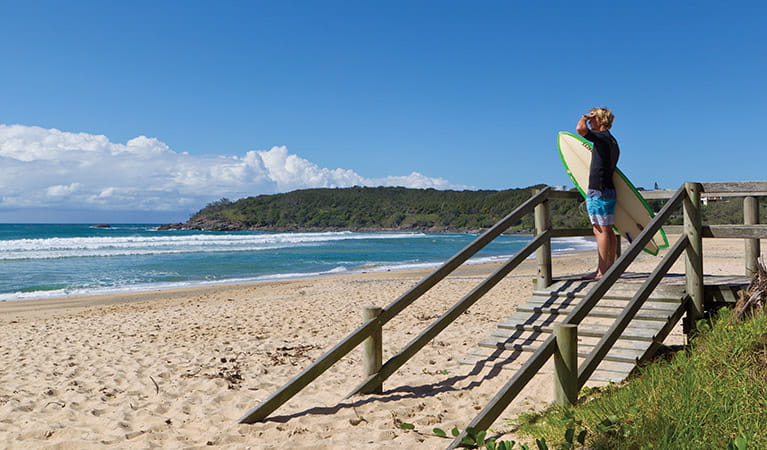
Golden beaches are the park’s premier attraction. Here, everything revolves around the water – whether you’re swimming and surfing in it, or walking and fishing beside it. Spend your days discovering the headland walking tracks, boat ramps, parklands and playgrounds. And no matter where you go, you’re bound to find a perfect spot for a beachside picnic. There are also plenty of dog-friendly areas at Coffs Coast Regional Park – just another of its popular features. Take your dog for a walk along one of the coastal paths, plus, there are several beaches with leash-free zones, meaning your pooch can zip about and enjoy the sand and sea as much as you do. The leash-free area around Corindi and Pipeclay beaches is a local favourite.
- Arrawarra Headland Soak up views of Solitary Islands Marine Park from Arrawarra Headland and Beach near Coffs Harbour. Fishing, surfing, swimming – it’s all here waiting for you to enjoy.
- Diggers Beach Located opposite the Big Banana in Coffs Harbour, Diggers Beach is excellent for surfing and learning to surf, plus fishing, swimming, birdwatching and beach walking.
- Emerald Beach Positioned near Look-at-me-now Headland, 20km from Coffs Harbour, Emerald Beach is a local surfing hotspot. Visit also for fishing or swimming, or for barbecues in the picnic area.
- Mullaway Beach and Headland Head south from Arrawarra to discover beautiful Mullaway Headland and Beach, near Coffs Harbour. Make the most of its picnic area and barbecues, go fishing or swimming.
Whale watchers
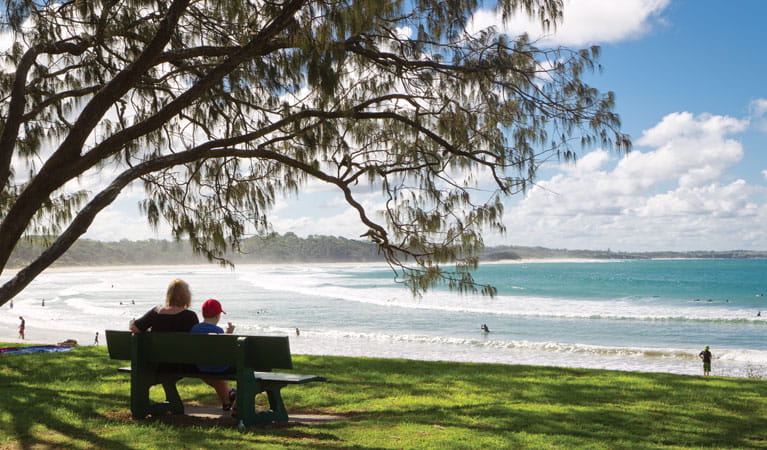
Coffs Coast Regional Park is a fantastic place to enjoy watching these majestic creatures on their long coastal journey. Look-At-Me-Now Headland near Emerald Beach is a great vantage point, but locals agree Woolgoolga Headland is your best bet for glimpsing humpbacks. In fact, it’s also known as ‘Whale Watch Headland’. Plan a trip between June and October to see this inspiring sight.
- Whale watching at Woolgoolga Join our NPWS guides for a free whale watching experience on the Coffs Coast. It's whale watching season – see how many whales you can spot out deep! Great for all ages.
- Woolgoolga Beach and Headland Woolgoolga Beach and Headland has the best whale watching in the Coffs Region, plus great surfing, fishing and picnics and scenic views.
Plants and animals protected in this park
Animals
-

White-bellied sea eagle (Haliaeetus leucogaster)
White-bellied sea eagles can be easily identified by their white tail and dark grey wings. These raptors are often spotted cruising the coastal breezes throughout Australia, and make for some scenic bird watching. Powerful Australian birds of prey, they are known to mate for life, and return each year to the same nest to breed.
-
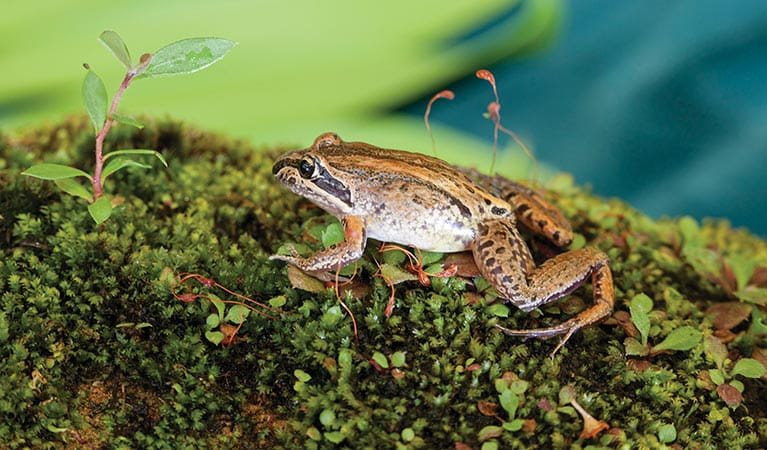
Brown-striped frog (Lymnastes peronii)
One of the most common frogs found in Australia, the ground-dwelling brown-striped frog lives in ponds, dams and swamps along the east coast. Also known as the striped marsh frog, this amphibian grows to 6.5cm across and has a distinctive ‘tok’ call that can be heard all year round.
-
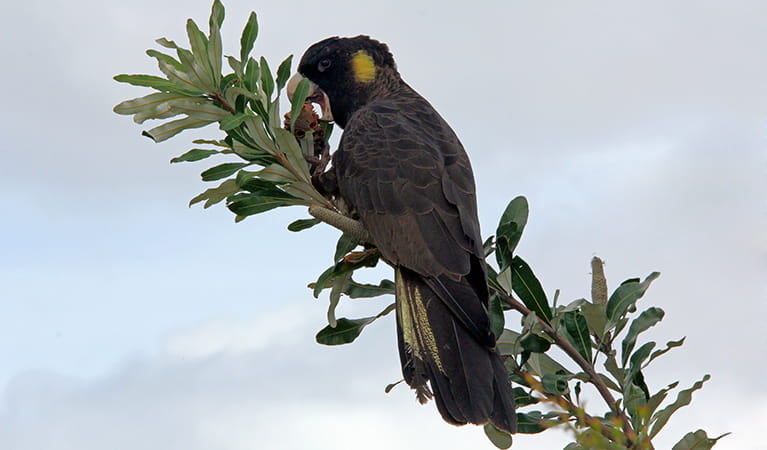
Yellow-tailed black cockatoo (Calyptorhynchus funereus)
The yellow-tailed black cockatoo is one of the largest species of parrot. With dusty-black plumage, they have a yellow tail and cheek patch. They’re easily spotted while bird watching, as they feed on seeds in native forests and pine plantations.
-
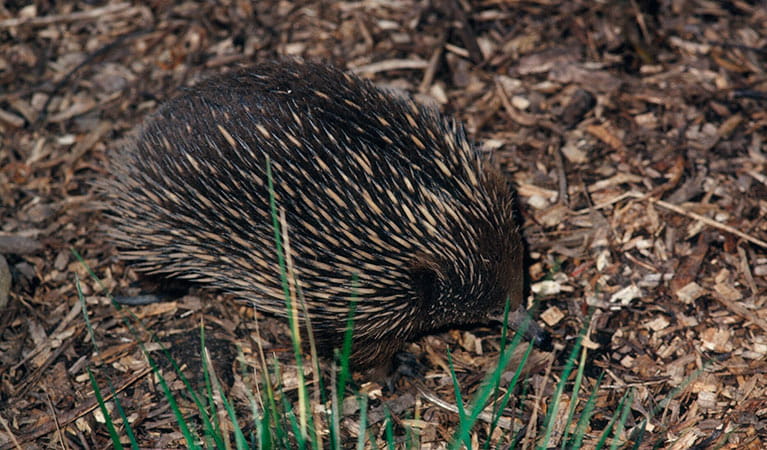
Short-beaked echidna (Tachyglossus aculeatus)
One of only 2 egg-laying mammals in the world, the short-beaked echidna is one of the most widespread of Australian native animals. Covered in spines, or quills, they’re equipped with a keen sense of smell and a tube-like snout which they use to break apart termite mounds in search of ants.
-
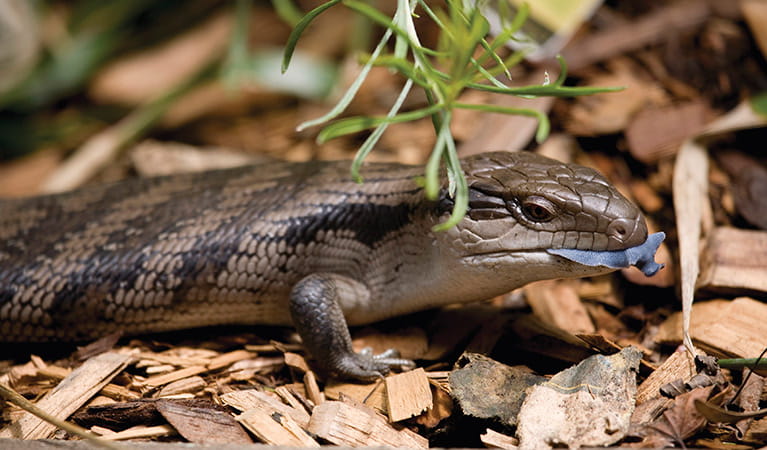
Eastern blue-tongue lizard (Tiliqua scinciodes)
The eastern blue-tongue lizard, one of the largest skinks in Australia, is found throughout most of NSW. When threatened, the eastern blue-tongue lizard displays its blue tongue in a wide-mouthed intimidating show. Not an agile animal, they feed on slow-moving beetles and snails.

